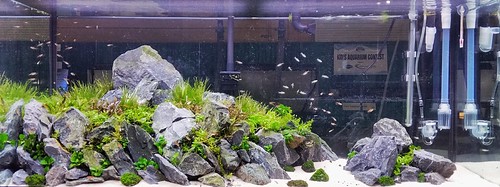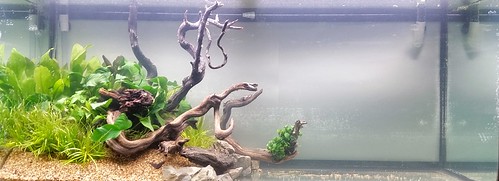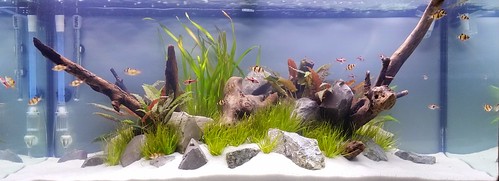An Evolution of the Remote Control LED Fixtures
February 16th, 2015Two years ago, I reviewed Current USA’s hit LED fixture, the Satellite Freshwater LED+, one of the first reasonably priced configurable LED fixtures to come on the market. Now, Current and Ecoxotic have released the next generation of this product line with the Satellite LED+ Pro and the E-Series LED lights.
Satellite LED+ Pro

Current’s Satellite LED+ Pro light is an evolutionary jump from the LED+ model. For starters, they include a ramp timer right in the box. Now, you can easily program the on/off times, and the timer will automatically simulate a 15 minute sunrise and sunset at those times. The sunrise and sunset transitions are very smooth with none of the flashing that could sometimes occur in the previous generation’s LED+ and ramp timer products. The IR-port is now integrated directly into the controller/timer unit, so you don’t need a separate IR receptor.
The light still has the same wonderful color output control with four presets of Sunlight (6500k), Full Spectrum (all on), Crisp Blue (10,000k), and Deep Water. Each of these modes tend to have lots of white light augmented by varying amounts of red/green/blue LEDs to create the slight color variations. Each are fully customizable, and they’ve included four programmable buttons; two completely custom (M1 and M2), and two convenience buttons for daylight and moonlight. Just like the previous model, the Satellite LED+ Pro has 8 dynamic modes allowing you to jump to moonlight, thunderstorm, cloud cover, and color fade presets. Unfortunately, you still cannot incorporate any of the dynamic modes into your custom programs or regular schedule.
Setting up the Satellite LED+ Pro is extremely simple. The light, controller, and power supply all connect with water resistant connectors, and they give you plenty of cable to place the controller with velcro (included) wherever is convenient. The remote looks very familiar to current Satellite LED+ users, but they have added a few buttons to aide in the programming of the unit. Programming is a breeze, utilizing the Set Clock button to set your local time, and Hour+ and Minute+ buttons to configure the on/off times, which also have their own dedicated buttons. I was up and running with an 8-hour photo period in less than 5 minutes!
The performance of the light is also improved with the LED+ Pro. In a side-by-side comparison of the 36″ LED+ and LED+ Pro lights on my 50G aquarium, I found the following PAR numbers using an Apogee Quantum Flux MQ-200 meter:
| Depth | LED+ Pro PAR | LED+ PAR |
|---|---|---|
| Surface | 140 | 75 |
| 8″ | 80 | 40 |
| 15″ | 30 | 21 |
As you can see, the output is just about double that of it’s predecessor. Overall, I’d qualify the Satellite LED+ Pro as an excellent medium output light from a company that is obviously interested in continuing to improve an already solid consumer offering.
Ecoxotic E-Series Full Spectrum LED
Ecoxotic produces equipment targeted at the higher-end consumer, and this focus is evident in their E-Series light. Functionally, the E-Series LED is almost identical to the LED+ Pro described above. However, they do sell an optional hanging kit allowing you to easily combine multiple units and suspend them over your tank as shown below.

They simplified the remote control slightly by combining the dynamic modes into four distinct modes, but still cover moonlight, thunderstorm with lightning, cloud cover, and color fade. At first glance, the E-Series LED could easily be confused with the Current product, as they have very similar housing, controller with built-in IR receptor, power supply, and remote. The main visual difference is the logo on the remote control. Otherwise, the big differentiator is the the performance!

The E-Series has the same ramp-up timer and four programmable modes as the LED+ Pro. The color variability is the same offering sunlight, full spectrum, crisp blue, and deep water presets with the option to customize the color mixing however you please. The PAR output, however, is significantly higher on the Ecoxotic:
| Depth | Ecoxotic E-Series | Current LED+ Pro PAR |
|---|---|---|
| Surface | 250 | 140 |
| 8″ | 115 | 80 |
| 15″ | 60 | 30 |
Just like the LED+ to LED+ Pro, the Ecoxotic E-Series LED light is roughly double that of the LED+ Pro, or four times the original LED+ model. I typically say that if you can get 60 PAR at the substrate, you’re going to be able to grow just about any plant in the hobby. I am also a big believer in having just enough light in your aquarium, but no more, to simplify the balancing of light, nutrients, and CO2. I think the Ecoxotic E-Series LED fixture has found this sweet spot for 18-20″ tall aquariums, while allowing significant customization at a price point lower than many high-end competitors.
Conclusion
The integrated timer, IR receiver, and consistent functionality make both the Current Satellite LED+ Pro and Ecoxotic E-Series LED lights solid products on the market. The color output of both is tremendous, and the increased PAR output means that these lights are usable in medium and high light situations, and I would recommend highly for these uses.















